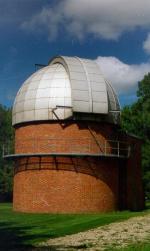| Warner and Swasey Observatory |
| Case Western Reserve University | Nassau Station |
| Visitors |
|
» Home » News » Gallery » Reference » Weather |
| Science Resources |
|
» NSRT User Interface » Software » Data Archive » Download Data |

|
 |
Nassau Station Robotic Telescope
Online Interface
Welcome to the Warner & Swasey Observatory Robotic Telescope located at the Nassau Astronomical Station near Chardon, OH, USA.
I have previously read and understand the information given below. Let me in.
If you are looking for pictures taken by the telescope go here.
Please be sure to check out the terms and conditions for using this interface.
The interface is not 100% ready to start operations yet. For a projected schedule see the latest status update for the project. Because of the enthusiastic response we have received from the general public we would like to make the telescope available for the time being on a limited basis.
The following rules will be followed for submitting requests to the observing queue:
No imaging of the Sun or Moon. They are too bright for our telescope and camera.
No imaging of Mercury or Venus, they are too close to the Sun. Observations of all other planets and minor planets are permitted.
No imaging of objects brighter than 3rd magnitude using a filter or brighter than 5th magnitude using no filter. This means defacto, no exposures of Mars, Jupiter, or Saturn.
Maximum allowed exposure times will be enforced with respect to the brightest object present in any given requested field. Meaning for example, if you request a field that has a 4th magnitude star in it (even if that star is not your intended target, it just has to be in the field), then that star as the brightest object will dictate the maximum exposure time allowed for your requested field. Absolutely no exceptions will be made.
No imaging of comets - this will take on the fly position calculations which we have not yet implemented though we do have the capability in the telescope.
No spectrographic observations until the spectrograph is completed and online.
Maximum length of a single exposure: 15 Minutes
No guided exposures - You must depend on the telescope tracking properly (for now). Any exposure over 2 minutes in length risks being smeared.
Maximum number of frames: 5 (all at the same position).
Do not worry about remembering all these rules. The proposal form should not let you submit a proposal that breaks any of the rules.
Not everything is automated from top to bottom yet so please be patient as we work to complete your proposals as efficiently as possible. We (Warner and Swasey Staff) are going to have to do a lot of the work by hand as we check out the robot and its systems. We will also have to contend with the weather in Northeast Ohio (can be real unpleasant in January/February) as we debug the robot. Data quality may be suspect to start but what we want for everyone is data which we would accept for our own use.
Keep in mind that what you receive when we complete your proposal is raw data in FITS format. You will be expected to do any image processing on your own. Click here for information on applications which you can use to display the FITS data. In the future we will have tutorials and software available to offer help with image processing but as of now that is unavailable.
If this is all a little mind boggling for you at the moment and you just want to see some pictures from the telescope, check out the picture gallery where we will be putting up pictures that may be of interest to the general public that we take.
We suggest a good place to start is creating a new user account. All user accounts and proposals that were created during the beta testing phase have been deleted.
These rules are subject to change as the Warner & Swasey staff sees fit.
Enter the Nassau Station Robotic Telescope User Interface
comments
Last modified October 16, 2001
Case Western Reserve University